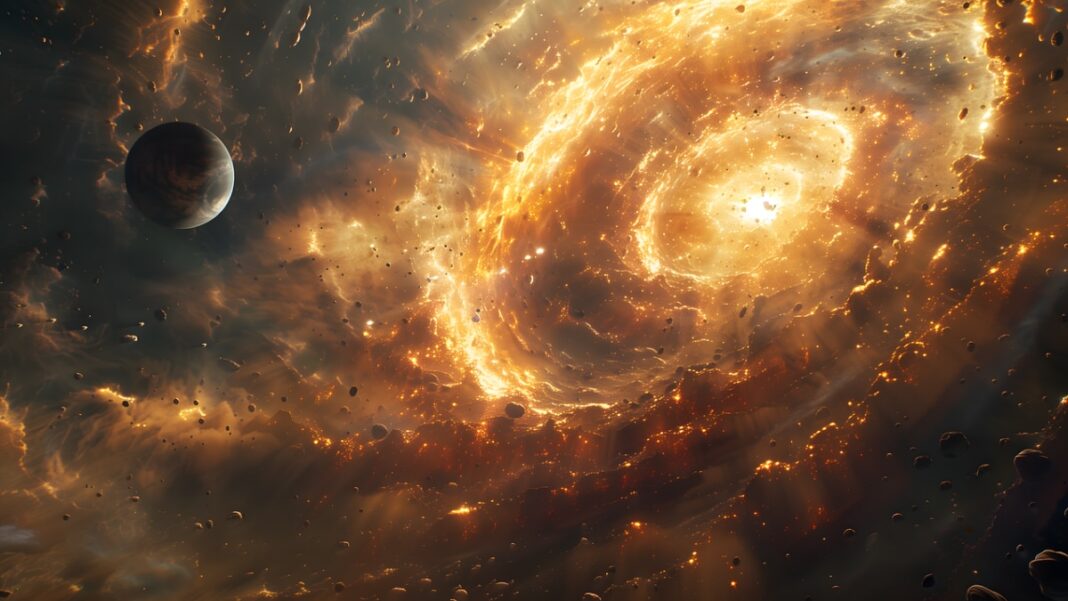Supermassive Black Holes: The Cosmic Dance of Binary Systems
In the vast expanse of the universe, hidden within the heart of galaxies, lie supermassive black holes – enigmatic entities that defy comprehension. While we often think of these cosmic behemoths as solitary giants, recent studies have unveiled a fascinating phenomenon: binary black hole systems, where two of these mysterious entities engage in a celestial tango.
Gravitational Waves and Galactic Collisions
Imagine galaxies merging, massive structures of stars and gas colliding in a cosmic dance. In these moments of chaos and creation, black holes from the merging galaxies draw closer, their gravitational embrace growing stronger. Eventually, they form a binary system, emitting gravitational waves – ripples in the fabric of space-time predicted by Einstein’s theory of general relativity.
Observatories like the Laser Interferometer Gravitational-Wave Observatory (LIGO) stand as sentinels, detecting these elusive waves. Yet, pinpointing individual binary systems remains a challenge, shrouded in the mysteries of the cosmos.
Evidence from Active Galactic Nuclei
Enter PG 1553+153, an active galaxy teeming with energy and intrigue. Researchers have uncovered tantalizing clues of a potential binary black hole system within its depths. Periodic light variations, occurring roughly every 2.2 years, hint at the presence of two black holes locked in a gravitational embrace.
These observations, while compelling, also spark questions. Could these patterns stem from other phenomena, like the wobbles of energetic jets? The cosmic stage is set for further investigation, as scientists delve deeper into the enigmatic dance of black holes.
Historical Data and Findings
Delving into the annals of cosmic history, researchers unearthed a treasure trove of data spanning over a century. Within this trove, a secondary 20-year light variation pattern emerged from PG 1553+153, bolstering the binary black hole hypothesis. The system, it seems, harbors two black holes in a delicate dance, their masses intertwined in a 2.5:1 ratio.
Yet, the final confirmation awaits the advancements of pulsar timing arrays, poised to detect the specific gravitational waves emanating from these cosmic duets. As we bridge the gap between past observations and modern simulations, a clearer picture of galactic evolution and black hole behavior emerges, painting a vivid tapestry of the cosmos.
Conclusion
In the cosmic ballet of supermassive black holes, the discovery of binary systems unveils a new chapter in our understanding of the universe. From the gravitational waves that ripple through space-time to the intricate dance of orbiting black holes, each revelation brings us closer to unraveling the mysteries that shroud the cosmos.
Frequently Asked Questions
1. What are supermassive black holes, and why are binary systems significant?
Supermassive black holes are believed to reside at the centers of galaxies, with binary systems offering insights into galaxy formation dynamics.
2. How are gravitational waves detected, and why are they important?
Gravitational waves are detected using observatories like LIGO and provide crucial information about cosmic events like black hole mergers.
3. What evidence supports the existence of binary black hole systems?
Observations of periodic light variations in active galaxies like PG 1553+153 suggest the presence of orbiting black holes.
4. How does historical data contribute to understanding cosmic phenomena?
Archival data spanning centuries can provide valuable insights into cosmic events, aiding in the interpretation of modern observations.
5. What role do pulsar timing arrays play in detecting gravitational waves?
Pulsar timing arrays are instrumental in detecting specific gravitational wave signatures, crucial for confirming the existence of binary black hole systems.
6. What implications do binary black hole systems have for galactic evolution?
The discovery of binary systems sheds light on the intricate processes that shape galaxies and the behavior of supermassive black holes.
7. How do gravitational waves help us understand space-time?
Gravitational waves offer a unique window into the fabric of space-time, allowing us to study the dynamics of the universe in unprecedented detail.
8. What challenges are faced in detecting binary black hole systems?
Detecting binary black holes presents challenges due to their indirect nature, requiring advanced technologies and sophisticated methods.
9. What future advancements are expected in the field of black hole research?
Technological improvements, such as enhanced pulsar timing arrays, are anticipated to refine our understanding of black hole behavior and cosmic evolution.
10. What are the broader implications of studying binary black hole systems?
Studying binary systems not only enhances our knowledge of galactic dynamics but also deepens our understanding of the fundamental forces that govern the cosmos.
Tags: supermassive black holes, binary black hole systems, gravitational waves, cosmic phenomena, galactic evolution, black hole research, space-time dynamics, pulsar timing arrays, technological advancements.

